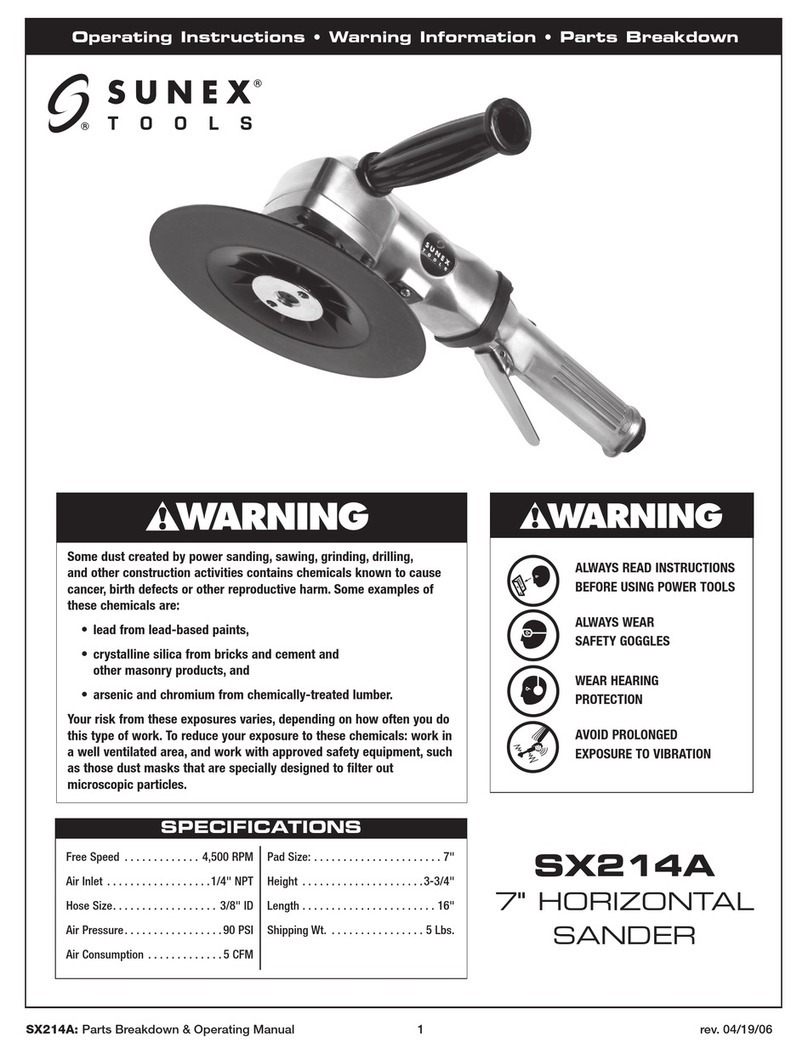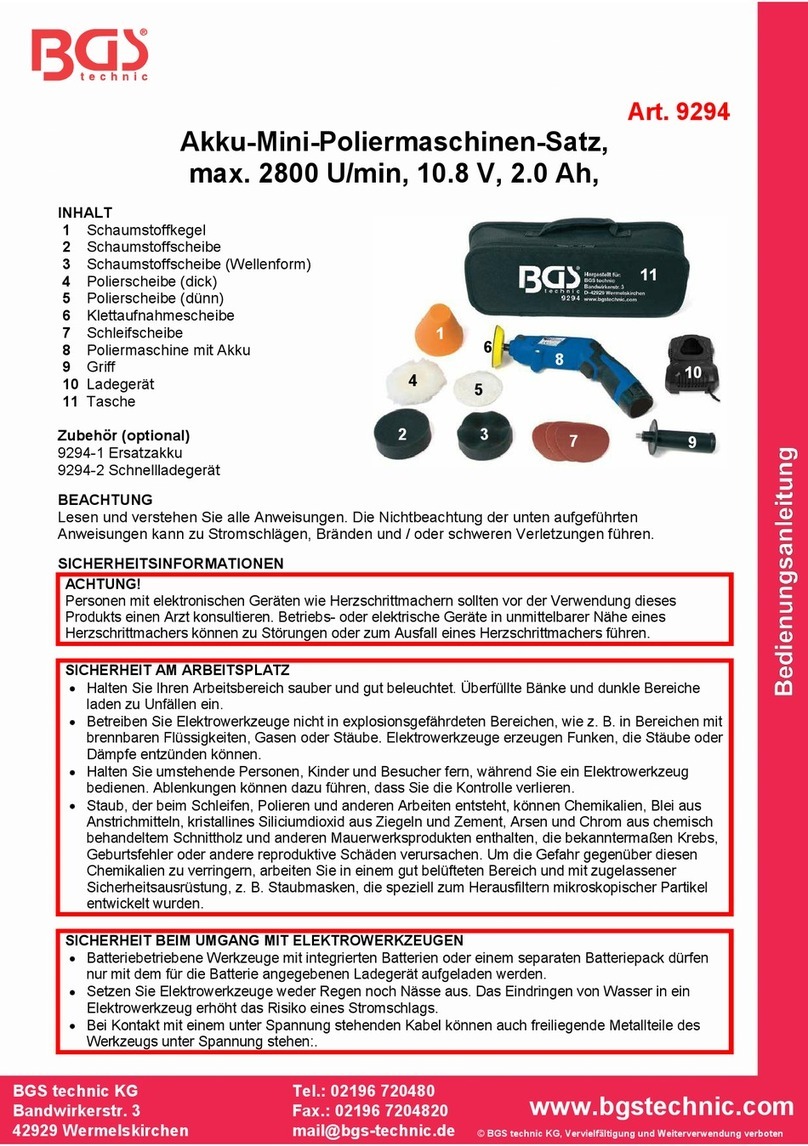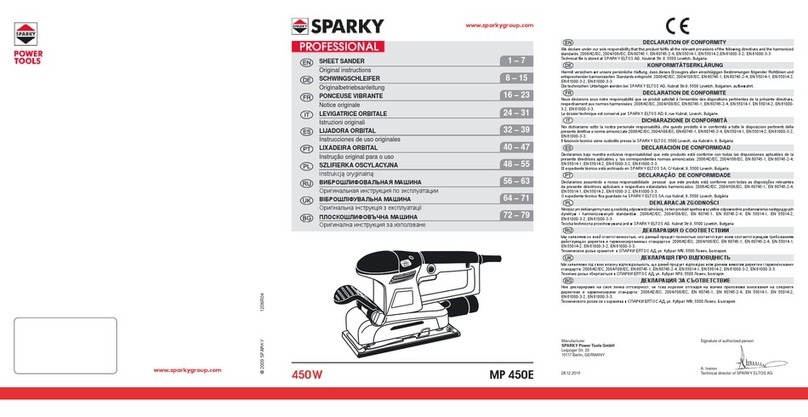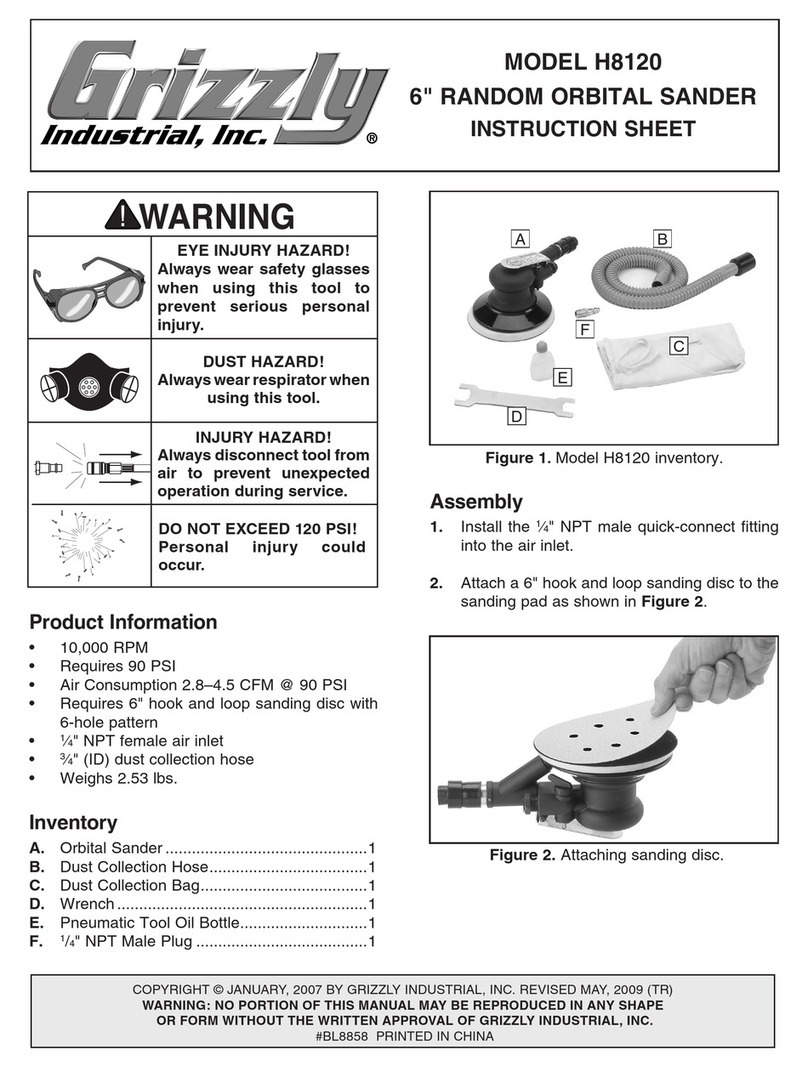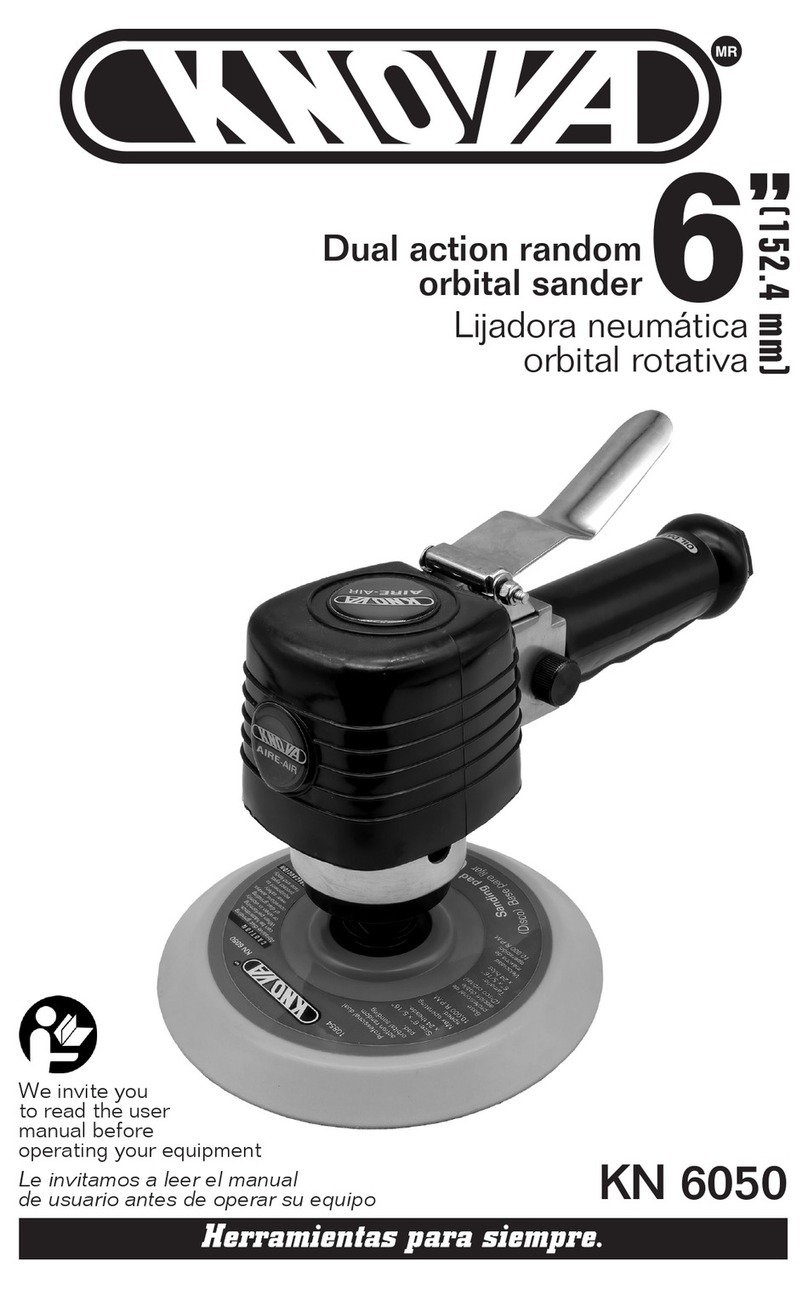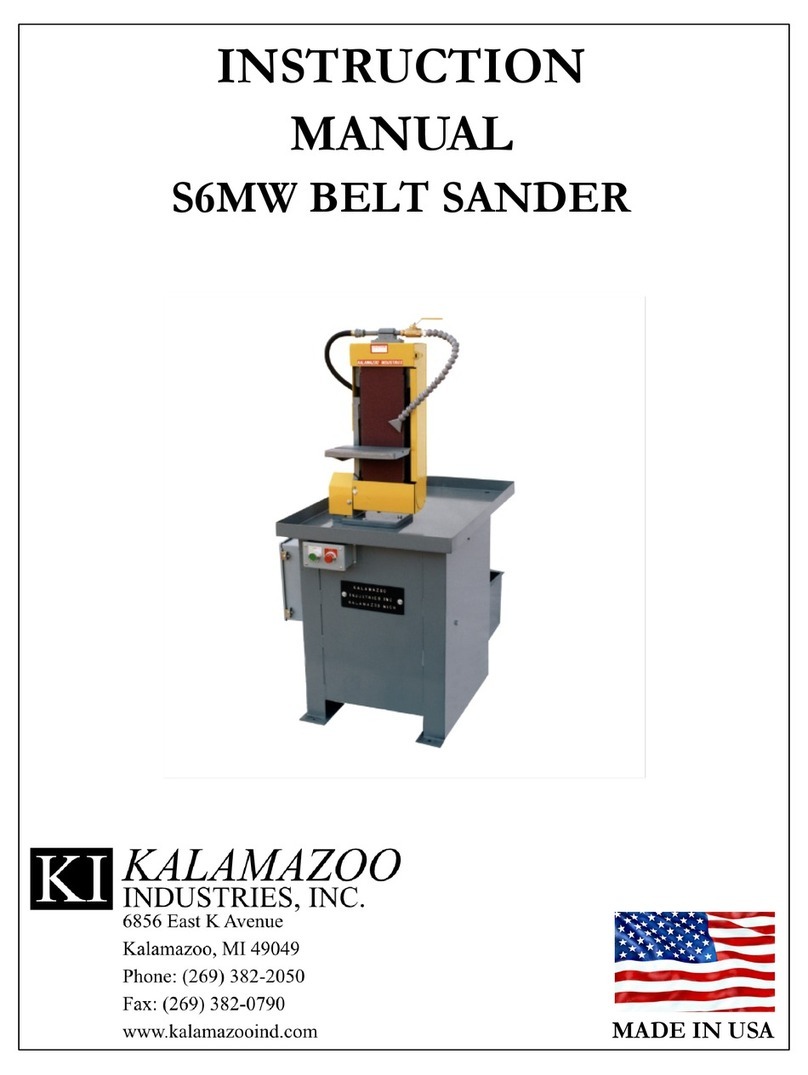TEH LS401 User manual

Tools for Every Home
Cordless Sander
LS401 LS402

LS401
DC 20V
8000-12000r/min
110*100MM
LS402
DC 20V
8000-12000r/min
125MM
LB2.0Ah/LB4.0Ah
LB2.0Ah/LB4.0Ah
Model
Rated Voltage
No Load Speed
Sanding Paper Size
Compatible Battery
Motor BrushlessBrushless
On/Off
Switch
Battery Release Button
Battery
Speed Control
Dust Bag
12

34
ELECTRICAL SAFETY
a) Power tool plugs must match the outlet. Never modify the plug in any way. Do not use any
adapter plugs with earthed (grounded) power tools. Unmodified plugs and matching outlets will
reduce risk of electric shock.
b) Avoid body contact with earthed or grounded surfaces such as pipes, radiators, ranges and
refrigerators. There is an increased risk of electric shock if your body is earthed or grounded.
c) Do not expose power tools to rain or wet conditions. Water entering a power tool will increase
the risk of electric shock.
d) Do not abuse the cord. Never use the cord for carrying, pulling or unplugging the power tools.
Keep cord away from heat, oil, sharp edges or moving parts. Damaged or entangled cords
increases the risk of electric shock.
PERSONAL SAFETY
a) Stay alert, watch what you are doing and use common sense when operating a power tool. Do
not use a power tool while you are tired or under the influence of drugs, alcohol or medication. A
moment of inattention while operating power tools may result in serious personal injury.
b) Use safety equipment. Always wear eye protection. Safety equipment such as dust mask, non-
skid safety shoes, hard hat, or hearing protection used for appropriate conditions will reduce the
risk of personal injuries.
c) Prevent unintentional starting. Ensure the switch is in the off-position before connecting to
power source and/or battery pack, picking up or carrying the tool.
Carrying power tools with your finger on the switch or energizing power tools that have the switch
on invites accidents.
d) Remove any adjusting key or wrench before turning the power tool on. A wrench or a key to a
rotating part of the power tool may result in personal injury.
e) Do not overreach. Keep proper footing and balance at all times. This enables better control of
the power tool in unexpected situations.
f) Dress properly. Do not wear loose clothing or jewellery. Keep your hair, clothing and gloves
away from moving parts. Loose clothes, jewellery or long hair can be caught in moving parts.
g) Store idle power tools out of the reach of children and do not allow persons unfamiliar with the
power tool or these instructions to operate the power tool. Power tools are dangerous in the hands
of untrained users.
h)Maintain power tools. Check for misalignment or binding of moving parts, breakage of parts
and any other condition that may affect the power tool’s operation. If damaged, have the power
tool repaired before use. Many accidents are caused by poorly maintained power tools.
e) When operating a power tool outdoors, use an extension cord suitable for outdoor use. Use of a
cord suitable for outdoor use reduces the risk of electric shock.
f) If operating a power tool in a damp location is unavoidable, use a residual current device (RCD)
protected supply. Use of an RCD reduces the risk of electric shock.

l) Keep cutting tools sharp and clean. Properly maintained cutting tools with sharp cutting edges
are less likely to bind and are easier to control.
n) Use the power tool, accessories and tool bits etc. in accordance with these instructions, taking
into account the working conditions and the work to be performed. Use of the power tool for
operations different from those intended could result in a hazardous situation.
Have your power tool serviced by a qualified repair person using only identical replacement parts.
This will ensure that the safety of the power tool is maintained.
SERVICE
USE AND HANDLING OF THE CORDLESS
ELECTRICAL POWER TOOL
a) Charge a rechargeable battery unit using only the charger recommended by the manufacturer.
Chargers are often designed for a particular type of rechargeable battery unit. There is the danger
of fire if other types of rechargeable battery units are used.
b) Only the rechargeable battery units supplied are to be used with an electrical power tool. The
use of other rechargeable battery units may lead to the danger of injury or fire.
c) When they are not being used, store rechargeable
battery units away from paperclips, coins, keys, nails, screws or other small metal objects that
could cause the contacts to be bridged. Short-circuiting the contacts of a rechargeable battery
unit may result in heat damage or fire.
d) Fluids may leak out of rechargeable battery units if they are misused. If this happens, avoid
contact with the fluid. If contact occurs, flush the affected area with water. Seek additional medical
help if any of the fluid gets into your eyes. Escaping battery fluid may cause skin irritation or burns.
a) Ensure that the device is switched off before inserting the battery. Inserting a battery into a
power tool that is switched on may result in accidents.
b) Recharge the batteries indoors only because the battery charger is designed for indoor use
only.
c) To reduce the electric shock hazard, unplug the battery charger from the mains before cleaning
the charger.
d) Do not subject the battery to strong sunlight over long periods and do not leave it on a heater.
Heat damages the battery and there is a risk of explosion.
e) Allow a hot battery to cool before charging.
f) Do not open up the battery and avoid mechanical damage to the battery. Risk of short circuit
and fumes may be emitted that irritate the respiratory tract. Ensure fresh air and seek medical
assistance in the event of discomfort.
g) Do not use non-rechargeable batteries!
SPECIAL SAFETY DIRECTIONS FOR BATTERY-OPERATED TOOLS
a) This device can be used by children aged 8 and over and by people with reduced physical,
sensory or mental capacities or with a lack of experience or knowledge, if they are supervised or
have been instructed regarding safe use of the device and understand the resulting risks. Children
are not permitted to play with the device. Cleaning and user maintenance are not to be undertaken
by children without supervision.
b) Children should be supervised to ensure that they do not play with the appliance.
c) To charge the battery, use only the charger supplied. Risk of fire and explosion. This ensures
that the safety of the device is maintained.
d) Before each use, check the charger, cable and plug and have them repaired by qualified
professionals and only with original parts. Do not use a defective charger and do not open it up
yourself. This ensures that the safety of the device is maintained.
CORRECT HANDLING OF THE BATTERY CHARGER
56

e) Connect the charger only to a socket with an earth. Ensure that the mains voltage matches the
specifications on the charger rating plate. Risk of electric shock.
f) Disconnect the charger from the mains before closing or opening connection to the battery /
power tool / device.
g) Keep the charger clean and away from wet and rain. Do not use the charger outdoors. Dirt and
the entry of water increase the risk of electric shock.
h) Operate the charger only with the appropriate original batteries. Charging other batteries may
result in injuries and risk of fire.
I) Avoid mechanical damage to the charger. This can result in internal short circuits.
j) Do not operate the charger on a combustible surface (e.g. paper, textiles). Risk of fire due to
heating during charging.
k) If the power cable for this equipment is damaged, it must be replaced by the manufacturer, a
customer service agent of the same or a similarly qualified person in order to prevent hazards.
l) The battery of the appliance is not fully charged at the time of delivery. It therefore needs to be
fully recharged before you use it for the first time. For the first recharge cycle we recommend that
you charge the battery for about 1 hour. Slot the battery into the base and plug the battery charger
into a mains outlet.
m) When the battery is fully charged, unplug the charger from the mains and from the appliance.
Charging time is approx. 1
hour.
n) Do not charge the battery continuously since this may damage the battery cells.
Note: Repeatedly charging small capacities may damage the battery cells. Recharge the battery
only if the appliance is becoming slow.
o) Do not use the charger to charge non-rechargeable batteries.
Even if properly operating and handling this electric tool, some residual risks will remain. Due to its
construction and build, this electric tool may present the following hazards:
RESIDUAL RISKS
During operation, this electric tool generates an electromagnetic field which, under
certain circumstances, may impair the functionality of active or passive medical
implants. To reduce the risk of serious or lethal injuries, we recommend that persons
with medical implants consult their doctor and the manufacturer of their medical
implant before operating the machine.
WARNING
a) Cuts
b) Ear damage if working without ear protection.
c) Damage to your health caused by swinging your hands and arms when operating the appliance
for longer periods of time or if the unit is not held or maintained properly.
1. Always use safety glasses or goggles. Ordinary eye or sun glasses are NOT safety glasses.
2. Hold the tool firmly.
3. Do not leave the tool running. Operate the tool only when hand-held.
4. This tool has not been waterproofed, so do not use water on the workpiece surface.
5. Ventilate your work area adequately when you perform sanding operations.
6. Some material contains chemicals which may be toxic. Take caution to prevent dust inhalation
and skin contact. Follow material supplier safety data.
7. Use of this tool to sand some products, paints and wood could expose user to dust containing
hazardous substances.Use appropriate respiratory protection.
8. Be sure that there are no cracks or breakage on the pad before use. Cracks or breakage may
cause a personal injury.
SANDER SAFETY WARNINGS
78

910
INSTALLATION INSTRUCTION
Always be sure that the tool is switched off and the battery cartridge is removed
before carrying out any work on the tool.
WARNING
Installing abrasive disc
To install the abrasive disc, first remove all dirt or foreign matter from the pad. Then attach the
abrasive disc to the pad. Be careful to align the holes in the abrasive disc with those in the pad.
Installing dust bag (optional accessory)
Install the dust bag on the tool with its mouth directing downwards.
Emptying dust bag
When the dust bag is about half full, switch off the tool, and remove the dust bag from the tool.
Then remove the dust nozzle from the dust bag after unlocking the dust nozzle by turning it
slightly counterclockwise. Empty the dust bag by tapping it lightly.
After emptying the dust bag, install the dust nozzle on the dust bag. Turn the dust nozzle slightly
clockwise to lock it in place. Then install the dust bag on the tool as described in "Installing dust
bag".
Installing paper filter bag (Optional accessory)
Make sure that the logo on the cardboard lip and the logo on the dust box are on the same side,
then install the paper filter bag by fitting the cardboard lip in the groove of each holding tab.
Make sure that the logo on the cardboard lip and the logo on the dust nozzle are on the same
side, then install the dust nozzle on the dust box.
Removing dust box and paper filter bag
Remove the dust nozzle by pushing the two latches.
Remove the paper filter bag first by pinching the logo side of its cardboard lip, then by pulling the
cardboard lip downwards to move it out of the holding tab of the dust box.
Do not use the tool without the skirt. Otherwise dust is scattered all over.
WARNING
You can choose one of 12 directions of the skirt in accordance with your purpose.
To remove the skirt, remove the screw and remove the skirt with slightly opening it for both sides.
To reinstall the skirt, install it with slightly opening it for both sides. And fasten the screw.
Removing and reinstalling the skirt
Do not set the skirt other than the designated angle. Otherwise the tool may be
damaged.
WARNING

11 12
OPERATION INSTRUCTION
Never switch on the tool when it is in contact with the workpiece, it may cause an
injury to operator.
WARNING
SANDING OPERATION
1. Never run the tool without the abrasive disc. You may seriously damage the pad.
2. Never force the tool. Excessive pressure may decrease the sanding efficiency,
damage the abrasive disc or shorten tool life.
3. Using the tool with the pad edge contacting the workpiece may damage the pad.
WARNING
Hold the tool firmly. Turn the tool on and wait until itattains full speed. Then gently place the tool
on theworkpiece surface. Keep the pad flush with theworkpiece and apply slight pressure on the
tool.
The sanding pad rotates clockwise during the loaded operation, but it may rotate
counterclockwise during the no-load operation.
WARNING
POLISHING OPERATION (OPTIONAL)
1. Use only a TEH genuine sponge pad, felt pad or wool pad (optional accessories).
2. Always operate the tool at low speed to prevent work surfaces from heating
abnormally.
3. Never force the tool. Excessive pressure may decrease the polishing efficiency
and cause motor overload, resulting in tool malfunction.
WARNING
1. Applying wax
Use an optional sponge pad. Apply Wax to thesponge pad or work surface. Run the tool at low
speed to smooth out wax.
a. First, wax a not conspicuous portion of the work surface to make sure that the
tool will not scratchthe surface or result in uneven waxing.
b. The tool starts with high speed mode. Be carefulwhen you start the tool. The wax
may be spattered.It is recommended that you spread wax with thetool stopped
before starting up the tool. Changethe speed mode to low immediately after you
startthe tool.
c. Always run the tool at low speed. Running it at highspeed may cause the wax to
spatter.
NOTE
2. Removing wax
Use an optional felt pad. Run the tool at low speed to remove wax.

3. Polishing
Use an optional wool pad. Run the tool at low speed and apply the Wool pad gently to the work
surface.
MAINTENANCE
1. Always be sure that the tool is switched off and the battery cartridge is removed
before attempting to perform inspection or maintenance.
2. Never use gasoline, benzine, thinner, alcohol or the like. Discoloration,
deformation or cracks may result.
WARNING
To maintain product SAFETY and RELIABILITY, repairs, carbon brush inspection and replacement,
any other maintenance or adjustment should be performed by TEH Authorized Service Centers,
always using TEH replacement parts.
WARRANTY CARD
ladies/gentlemen: employer:
contact number: fax number:
contact address:
warranty record:
post code:
IMPORTANT NOTE
1. The invoice and warranty card must be presented at the time of warranty.
2. The fuselage number on the invoice is the same as the fuselage number on the warranty card.
3. Once this warranty card is issued, if it is lost, it will not be reissued. Please keep it properly.
Note: The company reserves the right to amend the above provisions and has the final interpretation right in the
case that the warranty service does not violate national laws.
Dear customers, the warranty service for purchasing TEH products is as follows:
Under normal use, within one year from the date of purchase. It is guaranteed that the damage
is caused by the quality of the tool.
The following conditions occur during the warranty period, not covered by the warranty:
a. Any valid legal document (single ticket) certifying the date of purchase
b. Any damage caused by natural wear and overload
c. Any damage caused by the use of low-priced inferior accessories
d. Any damage caused by improper carrying, transportation or storage
e. Any product that has been opened, repaired, replaced, or modified by itself
f. Any damage caused by misuse, beyond the scope of use of the tool,
and failure to use and maintain in accordance with the instructions
13 14
This manual suits for next models
1
Table of contents
Popular Sander manuals by other brands
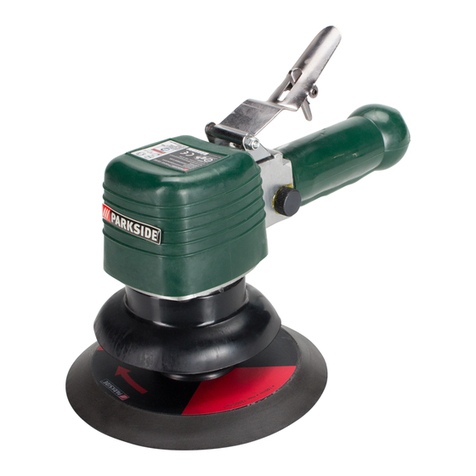
Parkside
Parkside 275679 instructions
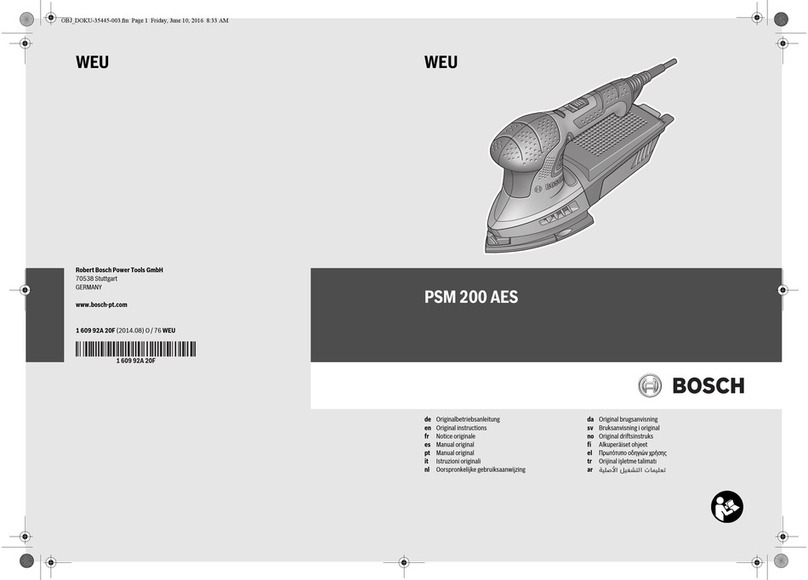
Bosch
Bosch 06033B6000 Original instructions

Makita
Makita PV001G instruction manual
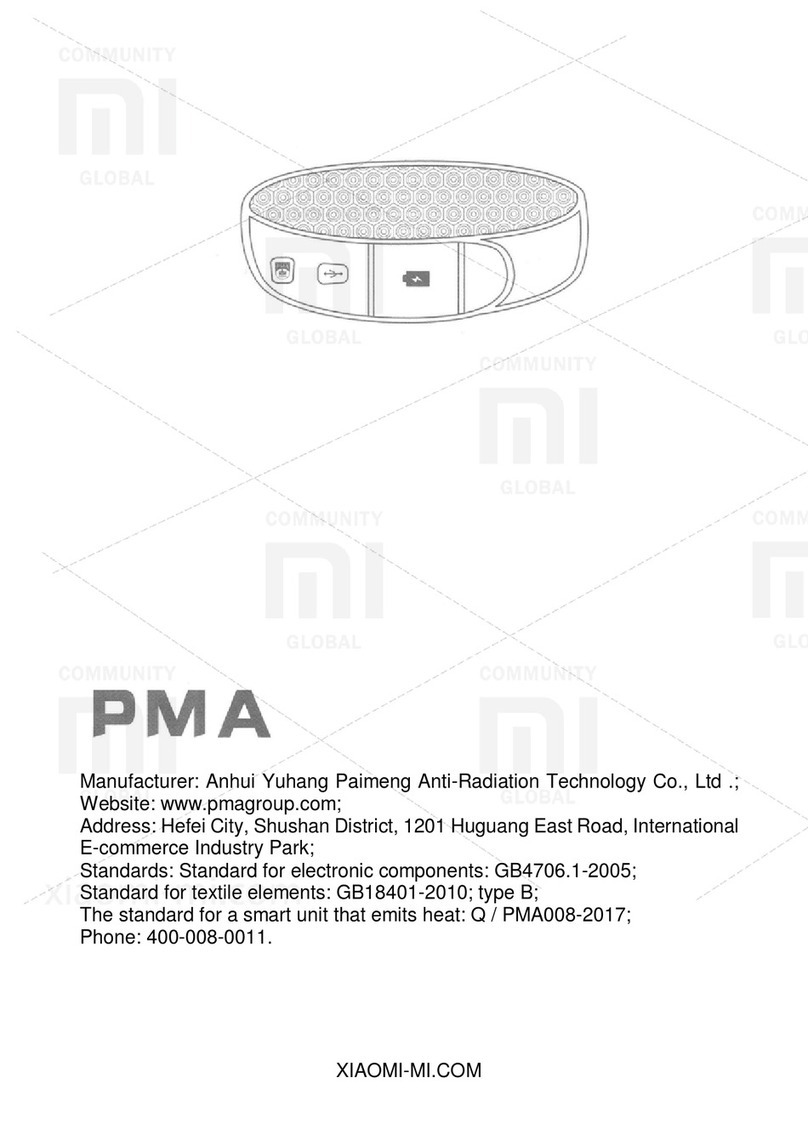
Xiaomi
Xiaomi PMA-A10 Series user guide
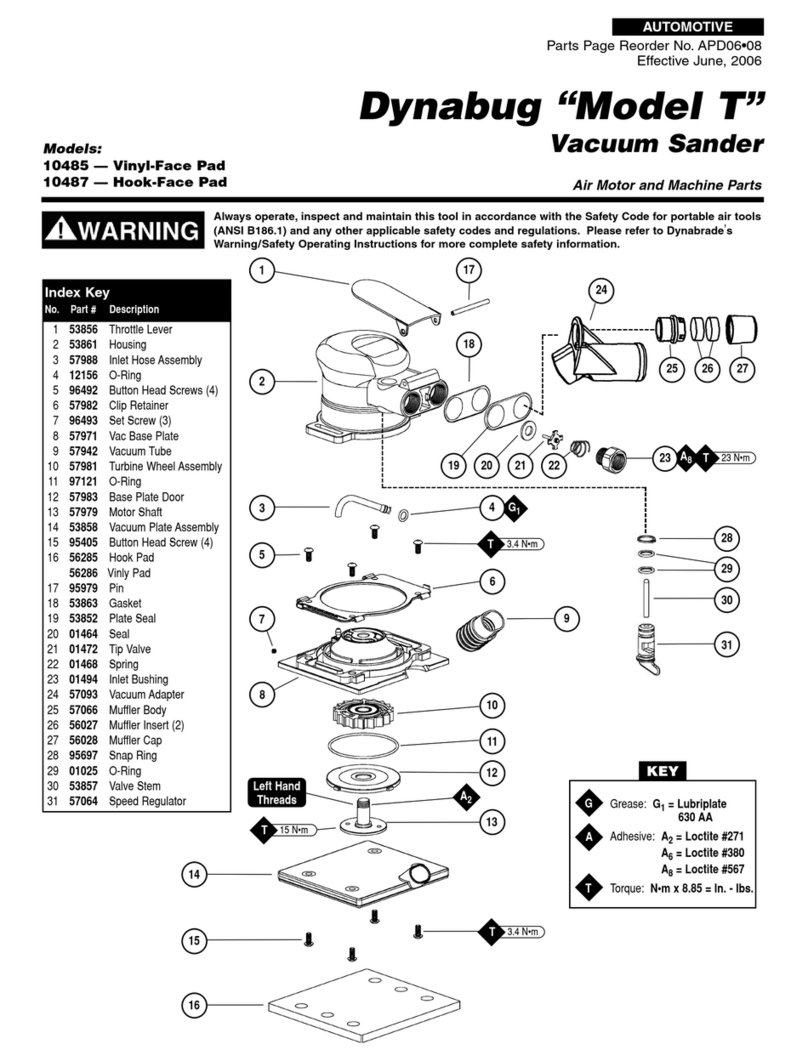
Dynabrade
Dynabrade Dynabug Model T 10485 Operating, maintenance and safety instructions

Ingersoll-Rand
Ingersoll-Rand 99S Operation and maintenance manual
